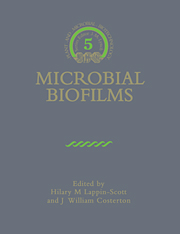Book contents
- Frontmatter
- Contents
- List of Contributors
- Series Preface
- Introduction to Microbial Biofilms
- Part I Structure, Physiology and Ecology of Biofilms
- 1 Growth of Microorganisms on Surfaces
- 2 Dynamics of Bacterial Biofilm Formation
- 3 Cultivation and Study of Biofilm Communities
- 4 Genetic Responses of Bacteria at Surfaces
- 5 Biochemical Reactions and the Establishment of Gradients within Biofilms
- 6 Mechanisms of the Protection of Bacterial Biofilms from Antimicrobial Agents
- Part II Biofilms and Inert Surfaces
- Part III Biofilms on the Surfaces of Living Cells
- Index
6 - Mechanisms of the Protection of Bacterial Biofilms from Antimicrobial Agents
Published online by Cambridge University Press: 24 November 2009
- Frontmatter
- Contents
- List of Contributors
- Series Preface
- Introduction to Microbial Biofilms
- Part I Structure, Physiology and Ecology of Biofilms
- 1 Growth of Microorganisms on Surfaces
- 2 Dynamics of Bacterial Biofilm Formation
- 3 Cultivation and Study of Biofilm Communities
- 4 Genetic Responses of Bacteria at Surfaces
- 5 Biochemical Reactions and the Establishment of Gradients within Biofilms
- 6 Mechanisms of the Protection of Bacterial Biofilms from Antimicrobial Agents
- Part II Biofilms and Inert Surfaces
- Part III Biofilms on the Surfaces of Living Cells
- Index
Summary
Introduction
Growth of microorganisms in close association with soft animal and plant tissue surfaces or upon non-living surfaces such as pipework, submerged materials or particulates in soil (Costerton et al. 1987), leads to the generation of microbial biofilms. In vivo biofilms often represent mono cultures (for example, Staphylococcus epidermidis infections of indwelling medical devices), whilst in other situations they are more likely to be comprised of diverse species and represent not only bacteria but also algae, protozoa and fungi. Organization of microbial populations into biofilms is thought to confer many advantages upon the component organisms (Costerton et al. 1985). These include in vivo protection from host immune defences, and conferment of some degree of homeostasis with respect to the physicochemical environment for growth. The extent to which the glycocalyx may modify the growth environment of the cells depends greatly upon the thickness of the biofilm and the density of the cells within it. In this latter respect, whilst the glycocalyx can function as an ion exchange column and exclude large, highly charged molecules, most solutes will equilibrate across it to be accessed by the resident cell population. Diffusion limitation by the glycocalyx, together with localized high densities of cells, will create gradients across the biofilm; thus, for biofilms established upon impervious surfaces, biological demand for oxygen creates within them microaerophilic/anaerobic conditions within the depth of the film yet aerobic conditions at the surface. Similar secondary metabolite, pH and nutrient gradients will also be established across the thickness of the biofilm.
Cells at different parts of the biofilm will experience different nutrient and physicochemical environments.
- Type
- Chapter
- Information
- Microbial Biofilms , pp. 118 - 130Publisher: Cambridge University PressPrint publication year: 1995
- 30
- Cited by



